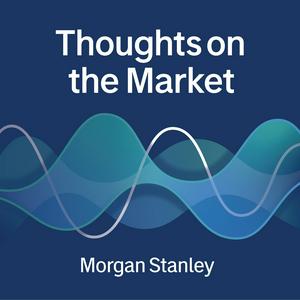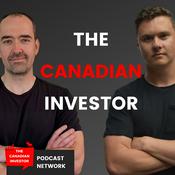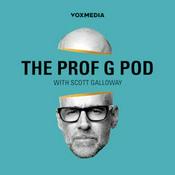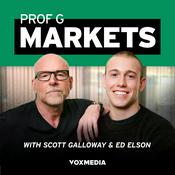1537 episodes

How Venezuela Events Could Affect Markets and Policy
2026-1-06 | 5 mins.
Our Deputy Director of Global Research Michael Zezas and our U.S. Public Policy Strategist Ariana Salvatore discuss the implications of the U.S action in Venezuela for global markets, foreign and domestic policy.Read more insights from Morgan Stanley.----- Transcript -----Michael Zezas: Welcome to Thoughts on the Market. I'm Michael Zezas, Deputy Global Head of Research for Morgan Stanley. Ariana Salvatore: And I'm Ariana Salvatore, Head of Public Policy Research. Michael Zezas: Today we're talking about the latest events in Venezuela and its implications for global markets.It's Tuesday, January 6th at 10am in New York. So, Ariana, before we get into it: Long time listeners might have noticed in our intro, a changeup in our titles. Ariana, you're stepping in to lead day-to-day public policy research. Ariana Salvatore: That's right. And Mike, you're taking on more of a leadership role across the research department globally. Michael Zezas: Right, which is great news for both of us. And because the interaction between public policy choices and financial markets is as critical as ever, and because collaboration is so important to how we do investment research at Morgan Stanley – tapping into expertise and insight wherever we can find it – you’re still going to hear from one of – and sometimes both of us – here on Thoughts on the Market on a weekly basis. Ariana Salvatore: And this week is a great example of this dynamic as we start the New Year with investors trying to decide what, if anything, the recent U.S. intervention in Venezuela means for the outlook for markets. Michael Zezas: Right. So, to that point, the New Year's barely begun, but it's already brought a dramatic geopolitical situation: The U.S. capture and arrest of Venezuela's President Nicolas Maduro – an event that can have far reaching implications for oil markets, energy, equities, sovereign credit, and politics. Ariana, thinking from the perspective of the investor, what's catching your attention right now? Ariana Salvatore: I think clients have been trying to get their arms around what this means for the future of U.S. foreign policy, as well as domestic policy making here too. On the first point, I would say this isn't necessarily a surprise or out of step with the goals that the Trump administration has been at least rhetorically emphasizing all year. Which is to say we think this is really just another data point in a pre-existing longer term trend toward multipolarity. Remember that involves linkage of economic and national security interest. It comes with its own set of investment themes, many of which we've written about, but one in particular would be elevated levels of defense spending globally, as we're in an increasingly insecure geopolitical world. Another tangible takeaway I would say is on the USMCA review. I think the U.S. has likely even more leverage in the upcoming negotiations, and likely is going to push even harder for Mexico to put up trade barriers or take active steps to limit Chinese investment or influence in the country. Enforcement here obviously will be critical, as we've said. And ultimately, we do still think the review results in a slightly deeper trade integration than we have right now. But it's possible that you see tariffs on non-USMCA compliant goods higher, for example, throughout these talks. Michael Zezas: And does this affect at all your expectations for domestic policy choices from the U.S.? Ariana Salvatore: I think it's important to emphasize here that we're just seeing an increasingly diminished role for Congress to play. The past year has been punctuated by one-off US foreign policy actions and a usage of executive authority over a number of different policy areas like immigration, tariffs, and so on. So, I would say the clearest takeaway on the domestic front is we're seeing a policy making pattern that is faster and more unilateral, right? If you don't need time for consensus building on some of these issues, decisions are being made by a smaller and smaller group of people. That in itself just increases policy uncertainty and risk premia, I would say across the board. But Mike, let's turn it back specifically to Venezuela. One of the most important questions is on – what this all means for global oil markets. What are our strategists saying there? Michael Zezas: Yeah. So, oil markets are the natural first place to look when it comes to the impact of these geopolitical events. And the answer more often than not is that the oil market tends not to react too much. And that seems to be the case here following the weekend’s Venezuela developments. That's because we don't expect there to be much short-term supply impact. Over the medium-term risks to Venezuela’s production skew higher. But while Venezuela famously holds one of the largest oil reserves in the world – it's about 17 percent of the world’s oil reserves – in terms of production, its contribution is relatively small. It's less than 1 percent of global output. So, among the top 10 reserve holders, Venezuela is by far the smallest producer. So, you wouldn't expect there to be any real meaningful supply impact in the markets, at least in the near term. So, one area where there has been price movement is in the market for Venezuela sovereign bonds. They have been priced for low recovery values and the potential restructuring that was far off. But now with the U.S. more involved and the prospect of greater foreign investment into the country's oil production, investors have been bidding up the bond price in anticipation of potentially a sooner restructuring and higher recovery value for the bonds. Ariana Salvatore: Right. And to that point, our EM sovereign credit strategists anticipate limited spillover to broader LatAm sovereign credit. Any differentiation is more likely to reflect degrees of alignment with the U.S. and exposure to oil prices and potential increases in Venezuelan production, which could leave Mexico and Columbia among relative under underperformers. Michael Zezas: Right. And this seems like it's going to be an important theme all year because the U.S. actions in Venezuela seem to be a demonstration of the government's willingness to intervene in the Western Hemisphere to protect its interests more broadly. Ariana Salvatore: That's right. So, it's a topic that we could be spending much more time talking about this year. Michael Zezas: Great. Well, Ariana, thanks for taking the time to talk. Ariana Salvatore: Great speaking with you, Mike. Michael Zezas: And as a reminder, if you enjoy Thoughts on the Market, please take a moment to rate and review us wherever you listen; and share Thoughts on the Market with a friend or colleague today.

The Bullish Signals That Investors Overlook
2026-1-05 | 5 mins.
Our CIO and Chief U.S. Equity Strategist Mike Wilson discusses key catalysts that investors may be missing, but that are likely to boost U.S. equities in 2026.Read more insights from Morgan Stanley.----- Transcript -----Welcome to Thoughts on the Market. I'm Mike Wilson, Morgan Stanley’s CIO and Chief U.S. Equity Strategist. Today on the podcast I’ll be discussing the converging market forces bolstering our bullish outlook for 2026. It's Monday, January 5th at 11:30am in New York. So, let’s get after it. The New Year is usually a time to look forward. But today, I want to take a step back and talk about what the market is missing. A series of bullish catalysts are lining up at the same time, and the market is still underestimating their collective impact. There’s been a lot of focus on individual positives—solid earnings growth, further Fed easing—but in our view, the real story is how these forces are reinforcing one another. Deregulation, positive operating leverage, accommodative monetary policy, and increasingly supportive fiscal policy are all working in the same direction. And as we head into mid-term elections later this year, these policy levers are likely to stay supportive.Importantly, this isn’t a market that’s already priced for the outcomes I envision. Positioning in cyclical trades remains relatively light, and sentiment in economically sensitive areas is far from exuberant. That combination—of improving fundamentals with cautious positioning—is exactly what tends to characterize the early stages of a recovery. I continue to believe these tailwinds are most underappreciated in cyclical areas like Consumer Discretionary Goods, Financials, Industrials, and small- and mid-cap stocks. Many of the indicators we track are only just beginning to turn higher. This doesn’t look late-cycle to me—it looks early in what I have deemed to be a rolling recovery. One reason investors have been hesitant is the sluggishness of traditional business-cycle indicators, particularly the ISM Manufacturing Purchasing Managers Index. There’s been a reluctance to press cyclical trades until those gauges clearly re-accelerate; and beneath that hesitation is a lingering anxiety that the U.S. economy could even slip back into a growth scare. My view is different. I believe a three year rolling recession ended with Liberation Day. If that’s true, then the moderate softness we’re now witnessing in lagging labor data is constructive for equities because it keeps the Fed leaning dovish for longer and more aggressive—a positive for equities. I see the second half of 2025 as the bottoming process for key macro indicators; with 2026 shaping up as a year of re-acceleration. Longer-cycle analysis supports this. Specifically, the 45-month cycle of the ISM Manufacturing Purchasing Managers Index points to a rebound. That recovery has been delayed—but not cancelled. Another tailwind that doesn’t get nearly enough attention is energy prices. Gasoline prices in particular are sitting near five-year lows, which is providing real economic relief for lower- and middle-income consumers. That cushion matters, especially as other parts of the economy firm. This past weekend’s events in Venezuela argue for lower oil prices for longer. From a sector standpoint, Financials stand out as the key beneficiary of deregulation and these stocks have been great performers over the past year in anticipation of these changes. I think there is more to go in 2026. Housing could be another important piece of the recovery. Subdued wage growth and falling rents may pressure home prices, while some builders are prioritizing volume over margins. While that may cap profitability for the builders, it could unlock housing velocity and feed into a more dovish inflation backdrop. Of course, there are also risks. Liquidity has been our top concern since September, and markets have reflected that through weakness in speculative assets. The good news is that the Fed has responded by ending quantitative tightening early and restarting asset purchases through the Reserve Management Program. This effectively adds liquidity to a system that was showing signs of stress this past several months. Another risk is a renewed slowdown in AI CapEx, particularly as markets demand clearer payback from debt-funded spending. And geopolitically, the U.S. intervention in Venezuela raises new questions. Strategically, it reinforces U.S. influence in the Western Hemisphere and supports our ‘Run It Hot’ thesis—but the key wildcard remains whether China chooses to react. Net-net, we think the balance of risks and rewards still favor leaning into this early-cycle recovery and our bullish outlook for US equities in 2026. Thanks for tuning in; I hope you found it informative and useful. Let us know what you think by leaving us a review. And if you find Thoughts on the Market worthwhile, tell a friend or colleague to try it out!

Bigger Tax Refunds Likely to Power the Economy
2026-1-02 | 3 mins.
Our U.S. Economist Heather Berger discusses how larger tax refunds in 2026 could boost income and help support consumer balance sheets throughout the year.Read more insights from Morgan Stanley. ----- Transcript -----Welcome to Thoughts on the Market and Happy New Year! I’m Heather Berger, from Morgan Stanley’s US Economics Team. On today’s episode – why U.S. consumers can expect higher tax refunds, and what that means for the overall economy. It’s Friday, January 2nd, at 10am in New York.As we kick off 2026, it’s not just a fresh start. It’s also the time when tax refund season is right around the corner. For many of us, those refunds aren’t just numbers on a page; they shape the way we budget for many everyday expenses. The timing and size of our refunds this year could make a real difference in how much we’re able to save, spend, or get ahead on bills.In the wake of the One Big Beautiful Bill Act, this year’s tax refund season is shaping up to be bigger than usual. The new fiscal bill packed in a variety of tax cuts for consumers. It also included spending cuts to programs such as SNAP benefits and Medicaid, but most of those cuts don’t pick up until later this decade. Altogether, this means that we’ll likely see personal incomes and spending power get a boost in 2026.Many of the new deductions and tax credits for consumers in the bill were made retroactive to the 2025 fiscal year. These include deductions for tips and overtime, a higher child tax credit, an increased senior deduction, and a higher cap on state and local tax deductions, among others. The retroactive portion of these measures should be reflected in tax refunds early this year. Overall, we’re expecting these changes to increase refunds by 15 to 20 percent on average. And different groups will benefit from different parts of the bill. For example, the higher state and local tax cap is likely to help high-income consumers the most, while deductions for tips and overtime will be most valuable to middle-income earners.Historically, U.S. consumers receive about 30 to 45 percent of tax refunds by the end of February, with then 60 to 70 percent arriving by the end of March. Because of the new tax provisions, we're anticipating a noticeable boost in personal income during the first quarter of the year. While we do also expect this legislation to encourage higher spending, it's unlikely that we'll see spending rise as sharply as income right away. According to surveys, most consumers say they use their refunds mainly for saving or paying down debt. This can lead to healthier balance sheets, which is shown by higher prepayment rates and fewer loan delinquencies during the tax refund season.When people choose to spend all or some of their tax refunds, they typically put that money toward everyday needs, travel, new clothes, or home improvements. Looking ahead, we do still see some near-term headwinds to spending, such as expected increases in inflation from tariffs and the expiration of the Affordable Care Act credits, which will most affect low-income consumers. As we progress throughout the year, though, we’re anticipating steady growth in real consumer spending as the labor market stabilizes, inflation decelerates, and lagged effects of easier monetary policy flow through. On top of that, this year’s larger tax refunds should give another lift to household spending.The boost to spending, along with other corporate provisions in the bill, should give the broader economy a push this year too. We expect the bill as a whole to support GDP growth in 2026. But it then becomes a drag on growth in later years when more of the spending cuts take effect.Thanks for listening. If you enjoy the show, please leave us a review wherever you listen and share Thoughts on the Market with a friend or colleague today.

Special Encore: What’s Driving U.S. Growth in 2026
2025-12-31 | 7 mins.
Original Release Date: November 25, 2025Our Chief U.S. Economist Michael Gapen breaks down how growth, inflation and the AI revolution could play out in 2026.Read more insights from Morgan Stanley.----- Transcript -----Michael Gapen: Welcome to Thoughts on the Market. I’m Michael Gapen, Morgan Stanley’s Chief U.S. Economist.Today I'll review our 2026 U.S. Economic Outlook and what it means for growth, inflation, jobs and the Fed.It’s Tuesday, November 25th, at 10am in New York.If 2025 was the year of fast and furious policy changes, then 2026 is when the dust settles.Last year, we predicted slow growth and sticky inflation, mainly because of strict trade and immigration policies – and this proved accurate. But this year, the story is changing. We see the U.S. economy finally moving past the high-uncertainty phase. Looking ahead, we see a return to modest growth of 1.8 percent in 2026 and 2 percent in 2027. Inflation should cool but it likely won’t hit the Fed’s 2 percent target. By the end of 2026, we see headline PCE inflation at 2.5 percent, core inflation at 2.6 percent, and both stay above the 2 percent target through 2027. In other words, the inflation fight isn’t over, but the worst is behind us.So, if 2025 was slow growth and sticky inflation, then 2026 and [20]27 could be described as moderate growth and disinflation. The impact of trade and immigration policies should fade, and the economic climate should improve. Now, there are still some risks. Tariffs could push prices higher for consumers in the near term; or if firms cannot pass through tariffs, we worry about additional layoffs. But looking ahead to the second half of 2026 and beyond, we think those risks shift to the upside, with a better chance of positive surprises for growth.After all, AI-related business spending remains robust and upper income consumers are faring well. There is reason for optimism. That said, we think the most likely path for the economy is the return to modest growth. U.S. consumers start to rebound, but slowly. Tariffs will keep prices firm in the first half of 2026, squeezing purchasing power for low- and middle-income households. These households consume mainly through labor market income, and until inflation starts to retreat, purchasing power should be constrained.Real consumption should rise 1.6 percent in 2026 and 1.8 [percent] in 2027 – better, but not booming. The main culprit is a labor market that’s still in ‘low-hire, low-fire’ mode driven by immigration controls and tariff effects that keep hiring soft. We see unemployment peaking at 4.7 percent in the second quarter of 2026, then easing to 4.5 percent by year-end. Jobs are out there, but the labor market isn’t roaring. It'll be hard for hiring to pick up until after tariffs have been absorbed.And when jobs cool, the Fed steps in. The Fed is cutting rates – but at a cost. After two 25 basis point rate cuts in September and October, we expect 75 basis points more by mid 2026, bringing the target range to 3.0-3.25 percent. Why? To insure against labor market weakness. But that insurance comes with a price: inflation staying above target longer. Think of it as the Fed walking a tightrope—lean too far toward jobs, and inflation lingers; lean too far toward inflation, and growth stumbles. For now the Fed has chosen the former.And how does AI fit into the macro picture? It’s definitely a major growth driver. Spending on AI-related hardware, software, and data centers adds about 0.4 percent to growth in both 2026 and 2027. That’s roughly 20 percent of total growth. But here’s the twist: imports dilute the impact. After accounting for imported tech, AI’s net contribution falls sharply. Still, we expect AI to boost productivity by 25-35 basis points by 2027, over our forecast horizon, marking the start of a new innovation cycle. In short: AI is planting the seeds now for bigger gains later.Of course, there are risks to our outlook. And let me flag three important ones. First, demand upside – meaning fiscal stimulus and business optimism push growth higher; under this scenario inflation stays hot, and the Fed pauses cuts. If the economy really picks up, then the Fed may need to take back the risk management cuts it's putting in now. That would be a shock to markets. Second, there’s a productivity upside – in which case AI delivers bigger productivity gains, disinflation resumes, and rates drift lower. And lastly, a potential mild recession where tariffs and tight policy bite harder, GDP turns negative in early 2026, and the Fed slashes rates to near 1 percent. So in summary: 2026 looks to be a transition year with less drama but more nuance, as growth returns and inflation cools, while AI keeps rewriting the playbook.Thanks for listening. If you enjoy the show, please leave us a review wherever you listen and share Thoughts on the Market with a friend or colleague today.

Special Encore: Investors’ Top Questions for 2026
2025-12-30 | 11 mins.
Original Release Date: December 3, 2025Our Global Head of Fixed Income Research and Public Policy Strategy Michael Zezas and Chief Global Cross-Asset Strategist Serena Tang address themes that are key for markets next year.Read more insights from Morgan Stanley.----- Transcript -----Michael Zezas: Welcome to Thoughts on the Market. I'm Michael Zezas, Global Head of Fixed Income Research and Public Policy Strategy.Serena Tang: And I'm Serena Tang, Morgan Stanley's Chief Global Cross-Asset Strategist.Michael Zezas: Today we'll be talking about key investor debates coming out of our year ahead outlook.It's Wednesday, December 3rd at 10:30am in New York.So, Serena, it was a couple weeks ago that you led the publication of our cross-asset outlook for 2026. And so, you've been engaging with clients over the past few weeks about our views – where they differ. And it seems there's some common themes, really common questions that come up that represent some important debates within the market.Is that fair?Serena Tang: Yeah, that's very fair. And, by the way, I think those important debates, are from investors globally. So, you have investors in Europe, Asia, Australia, North America, all kind of wanting to understand our views on AI, on equity valuations, on the dollar.Michael Zezas: So, let's start with talking about equity markets a bit. And one of the common questions – and I get it too, even though I don't cover equity markets – is really about how AI is affecting valuations. One of the concerns is that the stock market might be too high, might be overvalued because people have overinvested in anything related to AI. What does the evidence say? How are you addressing that question?Serena Tang: It is interesting you say that because I think when investors talk about equities being too high, of valuations – AI related valuations being very stretched, it's very much about parallels to that 1990s valuation bubble.But the way I approach it is like there are some very important differences from that time period, from valuations back then. First of all, I think companies in major equity indices are higher quality than the past. They operate more efficiently. They deliver strong profitability, and in general pretty solid free cash flow.I think we also need to consider how technology now represents a larger share of the index, which has helped push overall net margins to about 14 percent compared to 8 percent during that 1990s valuation bubble. And you know, when margins are higher, I think paying premium for stocks is more justified.In other words, I think multiples in the U.S. right now look more reasonable after adjusting for profit margins and changes in index composition. But we also have to consider, and this is something that we stress in our outlook, the policy backdrop is unusually favorable, right? Like you have economists expecting the Fed to continue easing rates into next year. We have the One Big Beautiful Bill Act that could lower corporate taxes, and deregulation is continuing to be a priority in the U.S.And I think this combination, you know, monetary easing, fiscal stimulus, deregulation. That combination rarely occurs outside of a recession. And I think this creates an environment that supports valuation, which is by the way why we recommend an overweight position in U.S. equities, even if absolute and relative valuation look elevated.Michael Zezas: Got it. So, if I'm hearing you right, what I think you're saying is that comparisons to some bubbles of the past don't necessarily stack up because profitability is better. There aren't excesses in the system. Monetary policy might be on the path that's more accommodative. And so, when compared against all of that, the valuations actually don't look that bad.Serena Tang: Exactly.Michael Zezas: Got it. And sticking with the equity markets, then another common question is – it's related to AI, but it's sort of around this idea that a small set of companies have really been driving most of the growth in the market recently. And it would be better or healthier if the equity market were to perform across a wider set of companies and names, particularly in mid- and small cap companies. Is that something that we see on the horizon?Serena Tang: Yes. We are expecting U.S. stock earnings to sort of broaden out here and it's one of the reasons why our U.S. equity strategy team has upgraded small caps and now prefer it over large caps. And I think like all of this – it comes from the fact that we are in a new bull market. I think we have a very early cycle earnings recovery here. I mean, as discussed before, the macro environment is supportive. And Fed rate cuts over the next 12 months, growth positive tax and regulatory policies, they don't just support valuations. They also act as a tailwind to earnings.And I think like on top of that, leaner cost structures, improving earnings revisions, AI driven efficiency gains. They all support a broad-based earnings upturn. and our U.S. equity strategy team do see above consensus 2026 earnings growth at 17 percent. The only other region where we have earnings growth above consensus in 2026 is Japan; for both Europe and the EM we are below, which drive out equal weight and slight underweight position in those two indices respectively.Michael Zezas: Got it. And so, since we can't seem to get away from talking about AI and how it's influencing markets, the other common question we get here is around debt issuance related to AI.So, our colleagues put together a report from earlier this year talking about the potential for nearly $3 trillion of AI related CapEx spending over the next few years. And we think about half of that is going to have to be debt financed. That seems to be a lot of debt, a lot of potential bonds that might be issued into the market – which, are credit investors supposed to be concerned about that?Serena Tang: We really can't get away from AI as a topic. And I think this will continue because AI-related CapEx is a long-term trend, with much of the CapEx still really ahead. And I think this goes to your question. Because this really means that we expect nearly another [$]3 trillion of data center related CapEx from here to 2028. You know, while half of the spend will come from operating cash flows of hyperscalers, it still leaves a financing gap of around [$]1.5 trillion, which needs to be sourced through various credit channels.Now, part of it will be via private credit, part of it would be via Asset Backed Securities. But some of it would also be via the U.S. investment grade corporate credit bond space. So, add in financing for faster M&A cycle, we forecast around [$]1 trillion in net investment grade bond issuance, you know, up 60 percent from this year.And I think given this technical backdrop, even though credit fundamentals should stay fine, we have doubled downgraded U.S. investment grade corporate credit to underweight within our cross asset allocation.Michael Zezas: Okay, so the fundamentals are fine, but it's just a lot of debt to consume over the next year. And so somewhat strangely, you might expect high yield corporate bonds actually do better.Serena Tang: Yes, because I think a high yield doesn't really see the same headwind from the technical side of things. And on the fundamentals front, our credit team actually has default rates coming down over the next 12 months, which again, I think supports high yield much better than investment grade.Michael Zezas: So, before we wrap up, moving away from the equity markets, let's talk about foreign exchange. The U.S. dollar spent much of last year weakening, and that's a call that our team was early to – eventually became a consensus call. It was premised on the idea that the U.S. was going to experience growth weakness, that there would also be these questions among investors about the role of the dollar in the world as the U.S. was raising trade barriers. It seemed to work out pretty well.Going into 2026 though, I think there's some more questions amongst our investors about whether or not that trend could continue. Where do we land?Serena Tang: I think in the first half of next year that downward pressure on the dollar should still persist. And you know, as you said, we've had a very differentiated view for most of this year, expecting the dollar to weaken in the first half versus G10 currencies. And several things drive this. There is a potential for higher dollar negative risk premium, driven by, I think, near term worries about the U.S. labor markets in the short term. And as investors, I think, debate the likely composition of the FOMC next year. Also, you know, compression in U.S. versus rest of the world. Rate differentials should reduce FX hedging costs, which also adds incentive for hedging activity and dollar selling.All this means that we see downward pressure on the dollar persisting in the first half of next year with EUR/USD at 123 and USD/JPY at 140 by the end of first half 2026.Michael Zezas: All right. Well, that's a pretty good survey about what clients care about and what our view is. So, Serena, thanks for taking the time to talk with me today.Serena Tang: And thank you for inviting me to the show today.Michael Zezas: And to our audience, thanks for listening. If you enjoy Thoughts on the Market, please leave us a review and share the podcast. We want everyone to listen.
More Business podcasts
Trending Business podcasts
About Thoughts on the Market
Listen to Thoughts on the Market, The Knowledge Project and many other podcasts from around the world with the radio.net app

Get the free radio.net app
- Stations and podcasts to bookmark
- Stream via Wi-Fi or Bluetooth
- Supports Carplay & Android Auto
- Many other app features
Get the free radio.net app
- Stations and podcasts to bookmark
- Stream via Wi-Fi or Bluetooth
- Supports Carplay & Android Auto
- Many other app features


Thoughts on the Market
download the app,
start listening.






























